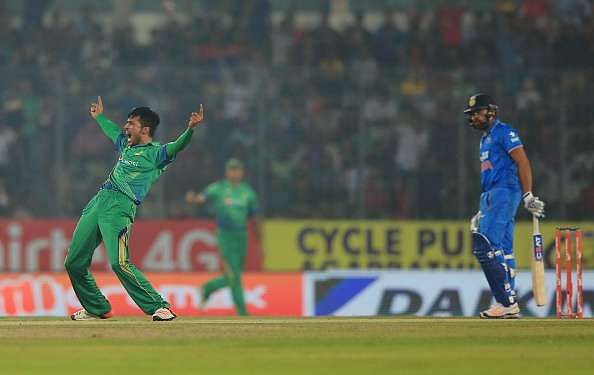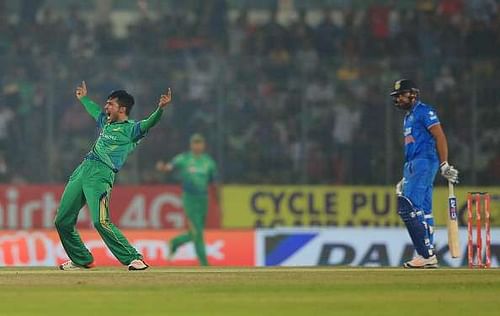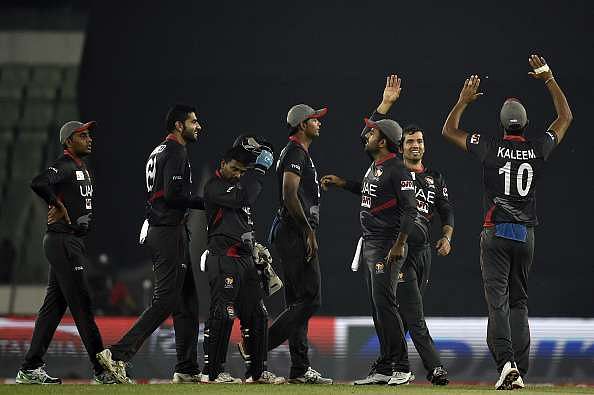
Why limited overs Cricket must be played on bowler friendly pitches
India were triumphant in the Asia Cup game against Pakistan in Mirpur and climbed to the top of the Asia Cup table. MS Dhoni's decision to bowl first upon winning the toss seemed fully justified as Pakistan were reduced to 42 for 6 by the end of 8 overs.
Pakistan's keeper Sarfaraz Ahmed then tried, in vain, to dig in and restore a semblance of respectability to the score and Pakistan were dismissed for a paltry total of 83. The target as expected proved to be too small to defend. Mohammad Amir put on quite a dazzling display of swing bowling, but his valiant effort was in vain as Kohli and Yuvraj played sensible knocks to guide India to the win.
Even so, the match was a lot closer than the scoreline suggests and when Amir had reduced India to 8 for 3, It was anyone’s game at that point.
What made this game so riveting to watch – the pitch. There was never any inevitability about India’s win. On that pitch, one poor shot could have led to a wicket, and then a new batsman walks out and he is not set, and he can be dismissed and suddenly the batting side is staring at a collapse.
That is what a good pitch is about. On a good pitch, a batsman can be set but even so he must always bat sensibly and he can never afford to be careless and play rash shots like he can on flat wickets. The contest between bat and all on such a pitch is never over, and a fall of wicket is always possible, and in cricket ‘wickets change matches’.
Is Cricket merely a game between one side’s batsmen vs other side’s batsmen?
Cricket is designed to be a contest between one side’s batsman versus the other side’s bowlers, but in recent years, the nature of the contest in limited overs cricket has changed. The pitches on which limited overs cricket is played, rarely have any help for the bowlers, and therefore, the ball and the bowlers have been taken out of the limited overs game almost entirely.
As a result, the traditional contest between bat and ball has disappeared and has been replaced by a contest between one side’s batsmen versus the other side’s batsmen. The bowlers don’t seem to matter in the limited overs game anymore, and the modern limited over’s game is purely about the batsmen. The bowlers have been reduced to being the side-kicks in limited overs cricket.
What the pitch showed today was that if the bowlers are put into the lead role again, then the contest becomes an even better one. It’s not hard to see where cricket lost its way when it comes to limited overs’ cricket pitches. The administrators wanted to serve up what the fans wanted the most in abundance – runs!
This is why the pitches got flatter, the boundaries got shorter, all kinds of fielding restrictions were imposed, and there were restrictions on the bowlers. All this was meant to make run scoring easier, as after all the fans came to the game to see runs being scored. So why not make it so that more and more runs could be scored.
This was a very poor way to deal with the situation. Think of football, and just as fans in cricket want to see runs, similarly fans in football flock to the grounds to see goals being scored. In football, goals are what sell the tickets. Now just imagine if football started to modify the rules to ensure more and more goals could be scored.
Like cricket limits the number of bouncers a bowler can bowl, what if football started to restrict the number of tackles a defender could make or the number of headers a defender could contest. Or what if football just made the goals bigger, like how cricket made the boundaries shorter.
The ‘Run-inflation’
I think everyone will agree that it would be a very poor way to approach things, but unfortunately that is exactly what cricket did to draw in the crowds. Besides the obvious flaws of taking this approach, there is also a hidden problem that this approach brought in – run Inflation.
In the money-driven inflation, once everyone has money, then effectively no one has money. Granted that's not exactly the definition of inflation but the basic idea is that if everyone has money then the value of money drops.
If I could buy 100 Kgs of rice with 100 Rs, and then there is a rise in inflation, then for the same 100 Rs, one can now only buy 80 Kgs of rice. So as inflation rises, the value of money drops.
This is what happens in cricket when run scoring becomes so easy that just about anybody and everybody can score runs. People appreciated 100’s because they were rare, and the batsman had to have bat really well to get to that total.
Hundreds were special back in the day. However, when just about anyone and everyone can score a 100, then how is scoring a 100 special anymore? Scoring a 100 is like scoring a 45, anybody and everybody can do it. The effects of this run inflation are visible today, as fans don’t rate 100’s that highly anymore. If earlier a batsman scored a 105 or 110 he was hailed as a hero.
Today a score of 110 or 115 runs doesn’t mean nearly as much to fans as it used to. Fans now want big hundreds, they want to see 150+ scores. Those are the ‘hundreds’ batsmen are expected to score today. This is nothing but run-inflation at work, and this is the hidden price batsmen and the game has had to pay for all those flat pitches. A hundred is worth a lot less than what it used to be.
Just think of Virat Kohli’s 49 yesterday, and he will remember that knock as being among the very best he has ever played, and that knock of 49 is worth a lot more than some of the 100’s that are scored today.
Besides lowering the value of runs, the flat pitches have made the game very predictable, and very one dimensional. Limited overs cricket means just one thing – runs, runs, runs! Therefore, the enjoyment factor has been taken away from the game. There is no element of surprise anymore in limited overs cricket.
There are some great innings under pressure and quality runs scored from time to time, but, because its so easy to score runs, for the most part, limited overs cricket is now about average batsmen scoring far more runs than their talent would ordinarily allow.
How Asia Cup is showing the way
The administrators of the game of cricket, have worked under the assumption that fans want to see close contests, but those close contests must always be high scoring ones. Will the fans enjoy low scoring close contests any less? Is the joy of watching batsmen score easy runs on flat wickets, really that much greater than the joy of watching spells like the one Amir bowled last night?
I feel this tournament has shown the way and the contests have been far more enjoyable than they would have been on flat wickets. None of them have been close contests, but even so they have been contests where at different times both sides have been in the driver’s seat at some point or the other. This element goes missing on flat wickets. Once a team is on its way to a big score the side chasing is always at a disadvantage.
Think of all the games so far in the Asia Cup. In the first match Bangladesh were dominant against India, and then Shakib dropped Rohit’s simple chance at point, and they proved to be pivotal. Had that catch been taken, India would have been staring at defeat.
Then the two games featuring UAE, where in both cases they dismissed both Sri Lanka and Bangladesh cheaply and were ahead in the contest at the innings break but failed to convert the advantage into a win.
In all these games both sides were always in the contest. Just think of what would have happened if Sri Lanka had batted first against UAE like they did, but on a flat track instead. Sri Lanka would have scored 180 runs and the UAE would have never even found a foothold into the contest.
There would have been no contest to speak. This is why I feel the Asia Cup has shown the way in T20 cricket and they must be played on bowler friendly wickets, either green pitches to help seam or dry wickets to help spin.
The reason why I restrict this to only T20 cricket and ODI is that the white ball stops swinging after 8-10 overs. In ODIs batsmen can just wait out these 10 overs and then the contest once again turns into a run-fest.
Granted it’s only a 40 over run fest but it is a run fest nonetheless. With T20Is, the batsmen don’t have the luxury of just playing out the first 10 overs. The batsmen have to find a way to overcome the adversity and still score briskly, like Rohit did in the first match against Bangladesh, or Kohli did against Pakistan.
This why it becomes such a riveting contest to watch, because the ball is dominating but the batsmen still have to find a way to score fast. It's tough and that is why it gets rid of the hidden issue of run inflation that has crept into cricket. If T20s are played on bowler friendly wickets, then they will become a whole lot more enjoyable.


